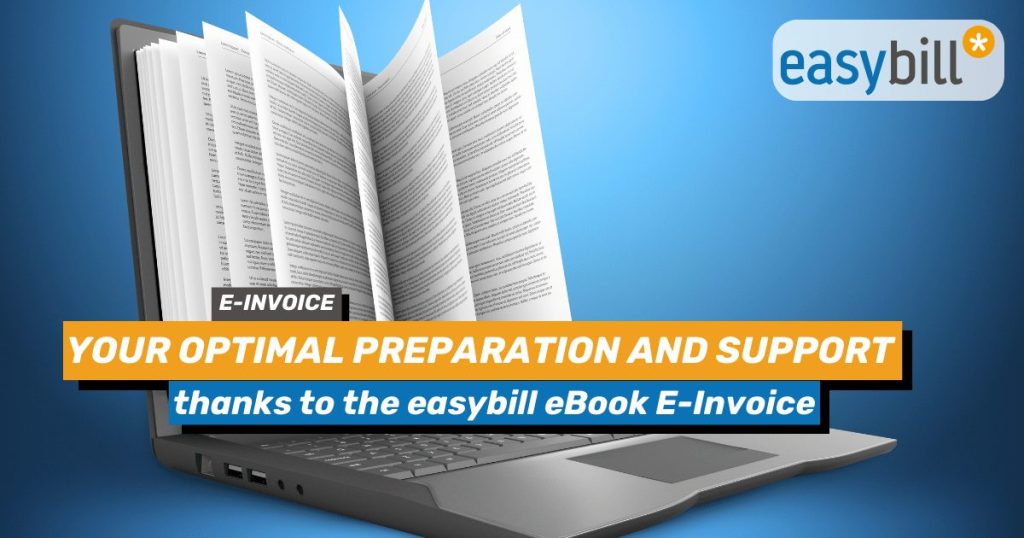
In today’s digital world, the transition to electronic invoices (e-invoices) is becoming increasingly important. Businesses of all sizes are recognizing the benefits that come with e-invoicing adoption, including cost savings, efficiency gains and improved environmental friendliness. But how best to prepare for the introduction of e-invoicing and what resources are available to facilitate this transition?
In this blog post, we’ll give you a comprehensive overview of e-invoicing, the necessary preparation steps and how easybill’s e-invoicing eBook can help you make this transformation a smooth one.
Download our e-book on the e-invoicing obligation 2025 for free!
What is an e-invoice?
An e-invoice is an electronic invoice that is created, sent and received in a structured digital format. Unlike traditional paper or PDF invoices, which have to be processed manually, the e-invoice enables automated processing and integration into existing accounting systems. This leads to a significant reduction in errors and delays as well as faster payment processing.
Advantages of the e-invoice
The switch to e-invoices offers numerous advantages:
- Cost savings: The processing costs for electronic invoices are considerably lower than for paper or PDF invoices. Companies save costs for printing, postage and archiving.
- Increased efficiency: Automated processes minimize the manual effort involved in creating, sending and processing invoices. This leads to faster processing and payment cycles.
- Improved accuracy: Electronic transmission minimizes input errors and data loss. This increases the accuracy of invoice data and reduces the need for corrections and reworking.
- Sustainability: Reducing paper consumption and transportation routes makes an important contribution to environmental protection.
Preparing for the introduction of e-invoicing
The introduction of e-invoicing requires careful planning and preparation. Here are the most important steps you should consider:
- Analysis of current processes: Examine your current invoicing processes to identify weaknesses and areas for improvement. This includes the creation, dispatch and processing of invoices.
- Choosing the right technology: Choose a suitable software solution for creating and sending e-invoices. Make sure that the solution meets the legal requirements and can be integrated into your existing systems.
- Training and education: Train your employees in how to use the new technology and the changed processes. Comprehensive training ensures that everyone involved can benefit from the advantages of e-invoicing and that potential sources of error are minimized.
- Test phase: Carry out a test phase in which you simulate the entire process from invoice creation to payment. This will help you identify and fix potential problems before the process goes live.
- Communication with business partners: Inform your business partners about the switch to e-invoices and clarify whether their systems are compatible. This is crucial for smooth integration and acceptance.
Support through the eBook e-invoice from easybill
To make the transition to e-invoicing easier for you, easybill offers a comprehensive eBook. This eBook serves as a guide and provides valuable information and practical tips for the introduction of e-invoicing. Here are some of the main contents of the eBook:
- The basics of e-invoicing: An introduction to e-billing, its advantages and the legal framework.
- Step-by-step guide: A detailed guide to the step-by-step implementation of e-invoicing in your company. This includes analyzing current processes, selecting technology, training employees and communicating with business partners.
- Best practices: Proven methods and strategies for the successful introduction and optimization of e-invoicing.
- Case studies: Practical examples that show how other companies have mastered the changeover and what successes they have achieved.
- Checklists and templates: Practical tools to help you keep track and ensure that you take all the necessary steps.
Conclusion
The introduction of e-invoicing offers numerous benefits and is an important step towards digital transformation. With careful planning and preparation, you can ensure that this transition goes smoothly and your business can reap the full benefits of e-invoicing. easybill’s eBook is a valuable resource to help you make this process a success. Take the opportunity to be fully informed and optimally prepared to benefit from the many advantages of e-invoicing.
Read also:
Successful offers for freelancers: tips and tricks for more orders
The introduction of mandatory e-invoicing from 2025 – What does this mean for companies?
Create e-invoices in ZUGFeRD 2.2 format (german help center)

